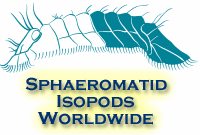| Abstract |
The genus Cymodocella Pfeffer, 1887, is revised and three new species are described from southern Australian coastal waters: Cymodocella ambonota sp. nov., from the central New South Wales coast, Cymodocella glabella sp. nov. (incertae sedis) from Lord Howe Island, and Cymodocella ankylosauria sp. nov. (incertae sedis) from coastal islands off South Australia. The genus is characterized by having an elongate, posteriorly directed, ventrally closed tube to the pleotelson, pleopod one with a medially indurate endopod and the antennule with colinear peduncular articles. Diclidocella gen. nov. is established for those tube-tailed Dynameninae with operculate first pleopods, short epistome and antennule peduncular article 2 posteriorly offset; three new species are described: Diclidocella bullata sp. nov., Diclidocella ngake sp. nov. and Diclidocella yackatoon sp. nov. (the latter two species being provisionally regarded as incertae sedis). The genus is recorded from Tasmania, Victoria, South Australia and southern Western Australia. Species of Cymodocella and Diclidocella gen. nov. belong to a distinct group of southern hemisphere genera. The diagnostic characters of this group are presented. Character states of the tube-tailed genera are reviewed. The phylogenetic significance and homoplasy of certain characters is assessed, in particular the occurrence of tube-tails within the Sphaeromatidae. Cladistic analysis of the species of Cymodocella suggests that the genus is a polyphyletic taxon. The phylogeny of the species and their geographic distribution are briefly discussed. Two species, on the basis of character evaluation resulting from examination of the types, are transferred to Ischyromene: I. bicolor (Barnard, 1914) comb. nov. and I. magna (Barnard, 1954) comb. nov. A key is given to the Australian genera and species of tube-tailed sphaeromatids. |

















